Plextor M5 Pro (256GB) Review
by Kristian Vättö on August 31, 2012 11:32 AM ESTAnandTech Storage Bench 2011
Last year we introduced our AnandTech Storage Bench, a suite of benchmarks that took traces of real OS/application usage and played them back in a repeatable manner. Anand assembled the traces out of frustration with the majority of what we have today in terms of SSD benchmarks.
Although the AnandTech Storage Bench tests did a good job of characterizing SSD performance, they weren't stressful enough. All of the tests performed less than 10GB of reads/writes and typically involved only 4GB of writes specifically. That's not even enough exceed the spare area on most SSDs. Most canned SSD benchmarks don't even come close to writing a single gigabyte of data, but that doesn't mean that simply writing 4GB is acceptable.
Originally we kept the benchmarks short enough that they wouldn't be a burden to run (~30 minutes) but long enough that they were representative of what a power user might do with their system. Later, however, we created what we refer to as the Mother of All SSD Benchmarks (MOASB). Rather than only writing 4GB of data to the drive, this benchmark writes 106.32GB. This represents the load you'd put on a drive after nearly two weeks of constant usage. And it takes a long time to run.
1) The MOASB, officially called AnandTech Storage Bench 2011—Heavy Workload, mainly focuses on the times when your I/O activity is the highest. There is a lot of downloading and application installing that happens during the course of this test. Our thinking was that it's during application installs, file copies, downloading, and multitasking with all of this that you can really notice performance differences between drives.
2) We tried to cover as many bases as possible with the software incorporated into this test. There's a lot of photo editing in Photoshop, HTML editing in Dreamweaver, web browsing, game playing/level loading (Starcraft II and WoW are both a part of the test), as well as general use stuff (application installing, virus scanning). We included a large amount of email downloading, document creation, and editing as well. To top it all off we even use Visual Studio 2008 to build Chromium during the test.
The test has 2,168,893 read operations and 1,783,447 write operations. The IO breakdown is as follows:
| AnandTech Storage Bench 2011—Heavy Workload IO Breakdown | ||||
| IO Size | % of Total | |||
| 4KB | 28% | |||
| 16KB | 10% | |||
| 32KB | 10% | |||
| 64KB | 4% | |||
Only 42% of all operations are sequential; the rest ranges from pseudo to fully random (with most falling in the pseudo-random category). Average queue depth is 4.625 IOs, with 59% of operations taking place in an IO queue of 1.
Many of you have asked for a better way to really characterize performance. Simply looking at IOPS doesn't really say much. As a result we're going to be presenting Storage Bench 2011 data in a slightly different way. We'll have performance represented as Average MB/s, with higher numbers being better. At the same time we'll be reporting how long the SSD was busy while running this test. These disk busy graphs will show you exactly how much time was shaved off by using a faster drive vs. a slower one during the course of this test. Finally, we will also break out performance into reads, writes, and combined. The reason we do this is to help balance out the fact that this test is unusually write intensive, which can often hide the benefits of a drive with good read performance.
There's also a new light workload for 2011. This is a far more reasonable, typical every day use case benchmark. It has lots of web browsing, photo editing (but with a greater focus on photo consumption), video playback, as well as some application installs and gaming. This test isn't nearly as write intensive as the MOASB but it's still multiple times more write intensive than what we were running last year.
We don't believe that these two benchmarks alone are enough to characterize the performance of a drive, but hopefully along with the rest of our tests they will help provide a better idea. The testbed for Storage Bench 2011 has changed as well. We're now using a Sandy Bridge platform with full 6Gbps support for these tests.
AnandTech Storage Bench 2011—Heavy Workload
We'll start out by looking at average data rate throughout our new heavy workload test:
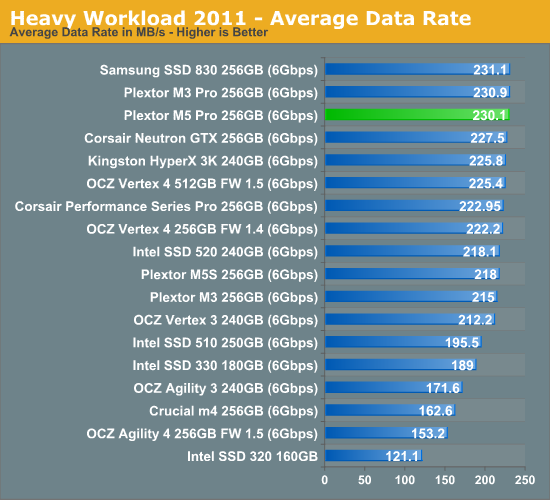
Surprisingly, the M5 Pro is slightly slower than the M3 Pro in our Heavy suite. In all of our synthetic benchmarks, the M5 Pro was faster and in some cases by far.
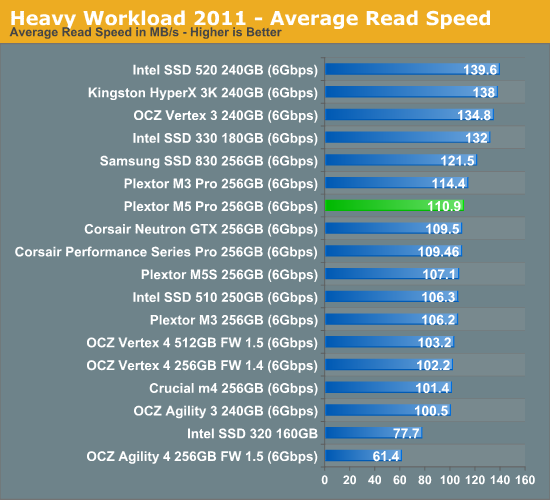
Read speed is where the M5 Pro is slower than the M3 Pro. While the difference is only 3.5MB/s, it's enough to make the average data rate smaller since our Heavy suite has more read operations. Write speed, on the other hand, is faster.
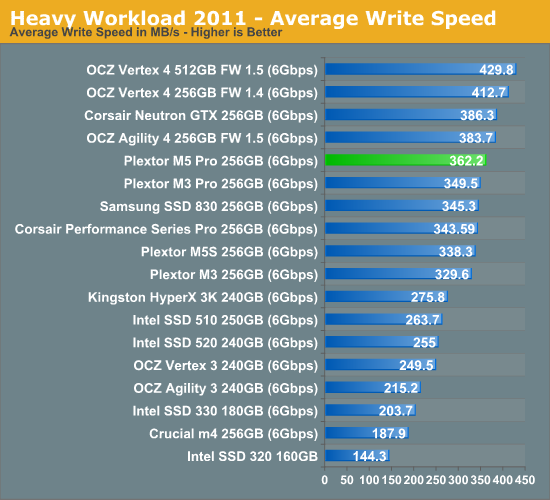
The next three charts just represent the same data, but in a different manner. Instead of looking at average data rate, we're looking at how long the disk was busy for during this entire test. Note that disk busy time excludes any and all idles; this is just how long the SSD was busy doing something:
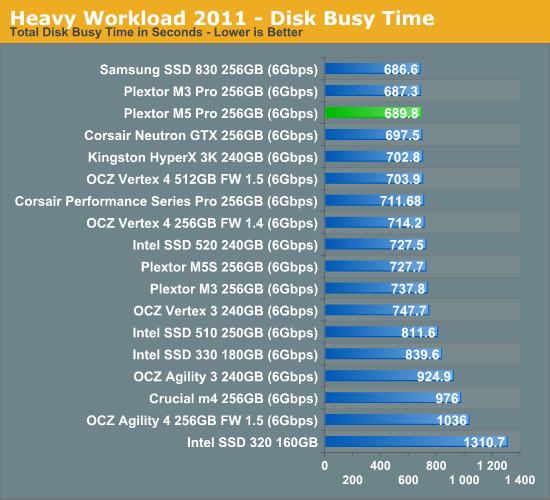
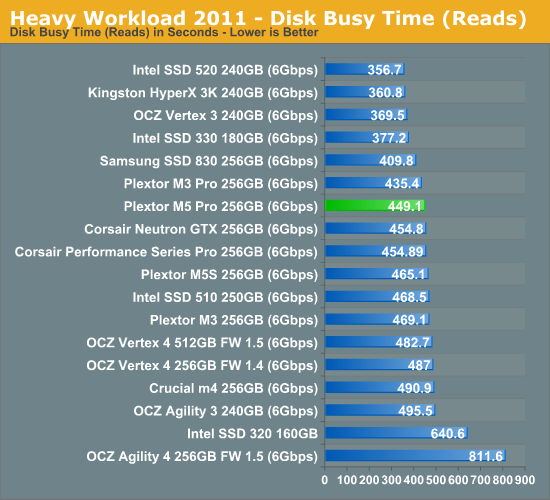
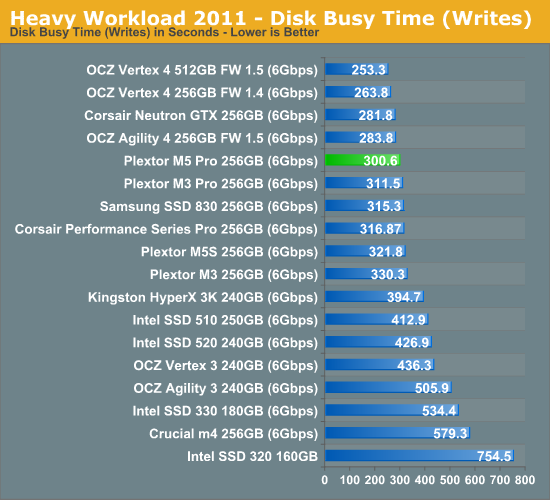










37 Comments
View All Comments
scottwilkins - Friday, August 31, 2012 - link
@bji: while not "immature", SSD is stil much younger than Winchester drive technology.@sheh: I wouldn't keep data on a Winchester longer than I would on an SSD. IMHO.
B3an - Friday, August 31, 2012 - link
Irrelevant. You'll get many years out of any SSD, enough for any consumer. The people who buy these sort of performance SSD's usually upgrade again within 2 or 3 years anyway. I upgrade every 18 months.Neutron bomb - Sunday, September 9, 2012 - link
Yes, flash memory loses its charge eventually, but eventually may be a very long way off. Does anyone know just how long it takes before flash memory begins to lose its charge?Beenthere - Friday, August 31, 2012 - link
Actually SSD tech is very IMMATURE TECH and this is proven weekly with the need for frequent firmware updates, compatibility and reliability issues, lost data, lost drive capacity, frequent RMAs, missing TRIM function, etc.Just because half-baked SSDs have been sold for a number of years doesn't mean that the tech is sorted, reliable or standardised. In fact the tech changes almost monthly and has proven to be quite unreliable/incompatible.
Anand himself stated about a year ago that SSD tech was "immature" and that statement is still true today. He suggested back then to wait 6-12 months from the time an SSD was released to see how it pans out.
Unfortunately the same advice is still appropriate today - to wait 6-12 months as the SSD makers are rushing half-baked crap to market for undeserved profits instead of conducting thorough validation of their products. It doesn't matter what the brand, they are all shipping half-baked SSD products in one form or another and consumers have no means to know what to expect from any given product.
kyuu - Friday, August 31, 2012 - link
Yeah... what a bunch of bull. Please show me any reputable source showing that late-model SSDs have failure/return rates higher than any other electronic good. You're behind the times; SSDs have gotten cheaper, and the issues have mostly been sorted. The major issues were pretty much isolated to Sandforce drives anyway.No, SSDs aren't perfect, but nothing is. HDDs go bad, have issues, are DoA as well, just like any consumer electronic. Your propoganda aimed at scaring people away from SSDs is disingenuous at best.
mura - Friday, August 31, 2012 - link
I have been using SSD extensively for the last two years - and (knock on wood) none of them has failed me yet. (4 x Intel X25V, 2 x Samsung 470, 2 x Samsung 830, Kingston V200+, Intel X18M, just to name a few - I don't remember the others exactly).They work in desktop computers, workstations and notebooks, and even in my office server. These machines FLY.
Oh, and to mention, almost all of these were bought, because some HDD has started producing bad sectors(mostly within the warranty period, but I did not want another slow and crappy product).
cosminmcm - Friday, August 31, 2012 - link
Come on guys, this is beenthere, why do you even bother?waldojim42 - Sunday, September 2, 2012 - link
As an owner of a Plextor M3 256GB drive (no S or P - this was made before then) I suffer none of the issues you commented about. I have never touched the firmware, it has been perfectly reliable, lost no data, and has yet to make me even consider an RMA. This is why people like me are willing to pay more for a quality product.When you talk about the immature drives, remember to differentiate a bit. The CHEAP drives are immature. Intel, Samsung, and Plextor all make top notch drives that easily rival the die hard 15K SCSI drives.
poccsx - Friday, August 31, 2012 - link
A-men to thatdishayu - Friday, August 31, 2012 - link
This is my first SSD for sure! Thanks for the review, although it took so much more time than expected.